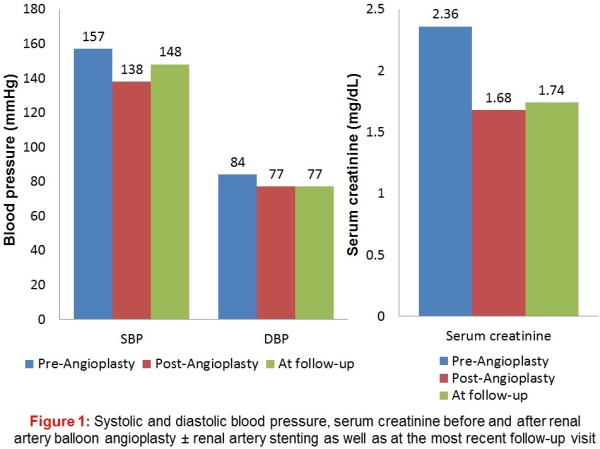Renal Allograft Outcomes with Renal Artery Angioplasty and/or Stenting in Transplant Renal Artery Stenosis.
E. Tantisattamo,1 A. Chokechanachaisakul,2 S. Pitukweerakul,3 P. Ratanasrimetha,4 A. Shetty,2 O. Traitanon,5 L. Gallon.2
1Oakland University William Beaumont School of Medicine, Royal Oak, MI
2Northwestern University, Chicago, IL
3Presence St. Francis Hospital, Evanston, IL
4Faculty of Medicine, Siriraj Hospital, Mahidol University, Bangkok, Thailand
5Thammasart University Hospital, Pathumthani, Thailand.
Meeting: 2016 American Transplant Congress
Abstract number: B230
Keywords: Angiography, Hypertension, Renal artery stenosis, Renal dysfunction
Session Information
Session Name: Poster Session B: Kidney: Cardiovascular and Metabolic
Session Type: Poster Session
Date: Sunday, June 12, 2016
Session Time: 6:00pm-7:00pm
 Presentation Time: 6:00pm-7:00pm
Presentation Time: 6:00pm-7:00pm
Location: Halls C&D
Background: The renal allograft function and blood pressure (BP) control after renal artery angioplasty±stenting for transplant renal artery stenosis (TRAS) is unclear. We aim to identify these outcomes after this procedure.
Methods: A computerized search of medical records from 2008 through 2015 yielded 1,905 kidney transplant recipients in whom angiography-proven TRAS was diagnosed in 19. Each 19 patients were individually matched to 2 subjects without TRAS based on age, gender, diabetes, and year of kidney transplantation.
Results: Mean age was 50.3+3.5 and 36.8% had diabetes. The onset of TRAS was 3.3+3.4 months. (range:0.4-63.2). The majority of patients were Caucasian (37%) and African American (32%) and 84% were male. At the time of angioplasty, SBP (157.3+4.6 vs. 138.3+ 3.7, p=0.003) and DBP (84.1+3.5 vs. 74.4+1.8, p=0.0074) were significantly higher in TRAS group while serum creatinine (SCr) did not differ. Mean SBP within 1 month after transplant renal artery angioplasty±stenting was significantly lower than pre-procedure SBP (137.9±6.7 vs. 157.3±4.6 mmHg, p=0.0186). However, mean DBP (77.4±2.9vs.84.1±3.5mmHg, p=0.0605) and SCr (1.7±0.2 and 2.4±0.6 mg/dL, p=0.6800) were not significantly different (Figure1). Mean duration of follow up after diagnosed TRAS was 2.1±0.4 years (range:0.02-6.3). There was no improvement in SBP, DBP, and SCr at the time of the most recent followed-up compared to those before angioplasty. Three-year renal allograft survivals were 94.7 and 92.1% in TRAS and non-TRAS groups, respectively. One patient (5%) had arterial dissection during the procedure.
Conclusions: Although decreasing BP in short-term, renal artery angioplasty±stenting may not improve BP and renal allograft function in the long-term follow-up with potential procedure-related complications.

CITATION INFORMATION: Tantisattamo E, Chokechanachaisakul A, Pitukweerakul S, Ratanasrimetha P, Shetty A, Traitanon O, Gallon L. Renal Allograft Outcomes with Renal Artery Angioplasty and/or Stenting in Transplant Renal Artery Stenosis. Am J Transplant. 2016;16 (suppl 3).
To cite this abstract in AMA style:
Tantisattamo E, Chokechanachaisakul A, Pitukweerakul S, Ratanasrimetha P, Shetty A, Traitanon O, Gallon L. Renal Allograft Outcomes with Renal Artery Angioplasty and/or Stenting in Transplant Renal Artery Stenosis. [abstract]. Am J Transplant. 2016; 16 (suppl 3). https://atcmeetingabstracts.com/abstract/renal-allograft-outcomes-with-renal-artery-angioplasty-andor-stenting-in-transplant-renal-artery-stenosis/. Accessed December 14, 2025.« Back to 2016 American Transplant Congress
